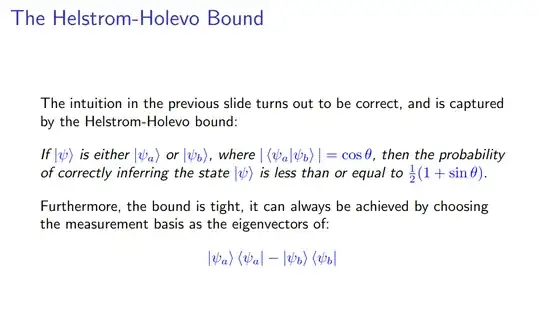I was trying to understand the fact that non-orthogonal quantum states cannot be reliably distinguished and I came across this link.
The explanation finishes with the result that the probability of successfully identifying a state between two non-orthogonal states is $Pr(success) ⩽ (1/2)(1 + sin(\alpha))$
This another reference discuss the fact in a more intuitively manner and then says that the probability of correctly inferring the state, when they are two non-orthogonal states with some angle $\theta$ between then is exactly the same as the first link. See the image below
It says that this result is "captured by the Helstrom-Holevo bound". From what I remember the Holevo bound is that it is a mathematical expression that gives an upper bound on the amount of accessible information that can be obtained from a quantum state. My questions are:
- This result $ 1 + sin(\alpha) $ comes from the use of the Holevo bound? If so.... how? I cannot see it
- The Holevo bound comes from the fact that non-orthogonal quantum states cannot be distinguished or it is a proof of this fact?
The only proof - or sketch of a proof - that I remember of this fact comes from Nielsen and Chuang but I never really liked - or understood - the proof, so if a good reference that proves it or discuss it in details could be given here I would really appreciate.
